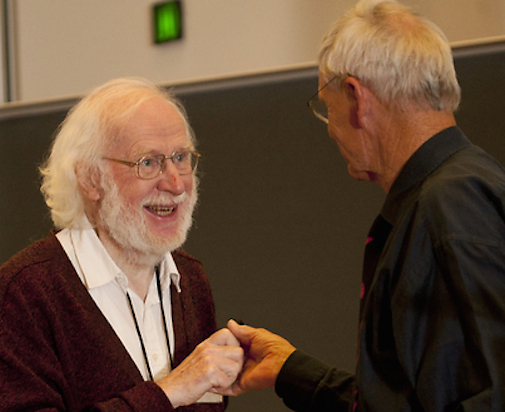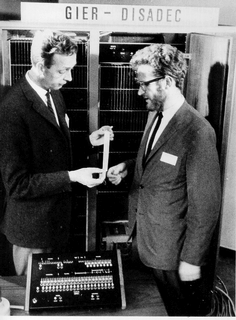Peter Naur a founding father of computer science
DIKU Hall of Fame presents: Peter Naur, Denmark's only Turing Award laureate, first Professor of computer science, and the inventor of the term 'datalogy'. Computer science throughout the world as well as locally at the Department of Computer Science at UCPH would not have been the same without Peter Naur, one of the founding fathers of computer science.

Peter Naur and Jakob Krarup shake hands at the celebration of DIKU's 40-year anniversary in 2010.
Peter Naur received the ACM A.M. Turing Award in 2005, the most prestigious distinction a computer scientist can get, for his work within computer science. The motivation for the award was: “For fundamental contributions to programming language design and the definition of Algol 60, to compiler design, and to the art and practice of computer programming." Apparently the award committee was well aware that Naur’s achievements on the international scene of computer science research have been many and extremely impressive.
But first we will direct our attention to Denmark where Naur more than anybody has been in a position to influence how, to this day, computer science as a field of research is carried out.
‘Datalogy’, DIKU, and Denmark’s first professor of computer science.

Niels Ivar Bech (left) and Peter Naur (right) in front of the computer GIER. Photo: Courtesy of Danish Data Historical Association.
According to Naur, it was evident that computer science was to be considered ”the science of the nature and use of data“, a definition which has had great currency at the Department of Computer Science (DIKU), and which is the foundation of what has been known internationally as the Copenhagen tradition of computer science.
In 1969, the University of Copenhagen offered Peter Naur Denmark’s first professorship in computer science (a position he held until 1998 when we retired as Professor Emeritus). This was the first step in founding DIKU as an autonomous department in April 1970. At this point, before computer science had set roots as an autonomous scientific discipline in Denmark, Naur had already made an impression on the international scene of computer science: i.e. Naur was present at the "birth" of computer science.
Algol 60
"
Several friends of mine, when asked to suggest a date of birth for Computing Science, came up with January 1960, precisely because it was Algol 60 that showed the first ways in which automatic computing could and should and did become a topic of academic concern.
- Edsger W. Dijkstra
In 1960, an international committee was formed with the purpose of creating a programming language which could be used for all computers so that the programming language no longer had to be an integrated part of the computer's hardware.
Peter Naur was the main author of the report describing this programming language which was named Algol 60. Naur was far-sighted enough to include recursion in the new language, a property which may seem obvious today, but which was very controversial in the middle of the 20th century. In Algol 60, Naur further introduced the notation technique known today as the Backus-Naur Form (BNF). With BNF the syntax of programming languages became well defined and as such it became possible, for the first time, to formalize programming languages.
During the 1960’s, Naur also made a name in Denmark. In 1961, the computer GIER was taken into use and Naur attributed to the work around GIER by writing an Algol compiler for it. A more comprehensive story of these first pioneering years written by Peter Naur himself can be found at the home page of Danish Data Historical Association (Danish). His academic work abroad and at home earned him G.A. Hagemanns Guldmedalje in 1963 for his work within the natural sciences, and in 1966 he received Danmarks Radios Rosenkjær-pris for his success as a communicator of complicated scientific subjects.
New humanistic interests
As apparent from Peter Naur’s personal home page, it is no longer computer science but the philosophical-psychological question about what computers can be programmed to do that occupies Peter Naur. Naur even perceives the summit of his career as fallling within the part of his professional life where he was concerned with psychology and not computer science:
- As the climax of my career I would mention the day in November 2003 when I, by reading Charles S. Sherringtons book The Integrative Actions of the Nervous System from 1906 bacame aware that the plastic elements in the nervous system which William James in his book The Principles of Psychology from 1890 points out must be the physiological foundation of the habits, are the same as Sherrington has discovered and calls synapses. My understanding of this circumstance is the foundation for those books about the nervous system that I have authored hereafter, writes Peter Naur in a letter.
During the 1970’s, the question about whether or not artificial intelligence is possible took up more and more of Naur’s research and his work has resulted in numerous publication on the subject. Naur’s answer is “No”: A computer’s way of processing data will never compare to a human’s way of making decisions. Naur defends his position with his Synapse-State Theory of Mental Life, which you can see him present on YouTube.
Curriculum vitae
Peter Naur
Birth
25th October 1928, Frederiksberg, Denmark
Education
Gymnasium in Copenhagen (1947)
Mag. scient. degree, Astronomy (University of Copenhagen, 1949)
PhD astronomy (University of Copenhagen, 1957).
Experience
Research Student at King’s College, Cambridge (1950–1951)
Researcher in Astronomy (U.S.A. 1952–1953)
Scientific assistant at Copenhagen Observatory (1953–1959)
Programmer at Regnecentralen (Copenhagen) and lecturer at University of Copenhagen (1959–1969)
Professor at Department of Computer Science, University of Copenhagen (1969–1999).
Honors and awards
G. A. Hagemann Medal (1963)
Jens Rosenkjaer Prize (1966)
Computer Pioneer Award of the IEEE Computer Society (1986)
ACM Alan M. Turing Award (2005).
Personal homepage
www.naur.com
